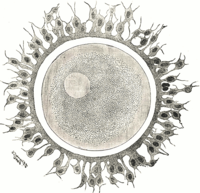
Photo from wikipedia
Infertility is one of the most important health concerns worldwide. It is characterized by not being successful of pregnancy after some periods of periodic unprotected sexual intercourse. In vitro fertilization… Click to show full abstract
Infertility is one of the most important health concerns worldwide. It is characterized by not being successful of pregnancy after some periods of periodic unprotected sexual intercourse. In vitro fertilization (IVF) is an assisted reproduction technique that efficiently addresses infertility. IVF replaces the actual mode of reproduction through a manual procedure wherein embryos are cultivated in a controlled laboratory environment until they reach the blastocyst stage. The standard IVF procedure includes the transfer of one or two blastocysts from several blastocysts that are grown in a controlled environment. The morphometric properties of blastocysts with their compartments such as trophectoderm (TE), zona pellucida (ZP), inner cell mass (ICM), and blastocoel (BL), are analyzed through manual microscopic analysis to predict viability. Deep learning has been extensively used for medical diagnosis and analysis and can be a powerful tool to automate the morphological analysis of human blastocysts. However, the existing approaches are inaccurate and require extensive preprocessing and expensive architectures. Thus, to cope with the automatic detection of blastocyst components, this study proposed a novel multiscale aggregation semantic segmentation network (MASS-Net) that combined four different scales via depth-wise concatenation. The extensive use of depthwise separable convolutions resulted in a decrease in the number of trainable parameters. Further, the innovative multiscale design provided rich spatial information of different resolutions, thereby achieving good segmentation performance without a very deep architecture. MASS-Net utilized 2.06 million trainable parameters and accurately detects TE, ZP, ICM, and BL without using preprocessing stages. Moreover, it can provide a separate binary mask for each blastocyst component simultaneously, and these masks provide the structure of each component for embryonic analysis. Further, the proposed MASS-Net was evaluated using publicly available human blastocyst (microscopic) imaging data. The experimental results revealed that it can effectively detect TE, ZP, ICM, and BL with mean Jaccard indices of 79.08, 84.69, 85.88%, and 89.28%, respectively, for embryological analysis, which was higher than those of the state-of-the-art methods.
Journal Title: Biomedicines
Year Published: 2022
Link to full text (if available)
Share on Social Media: Sign Up to like & get
recommendations!